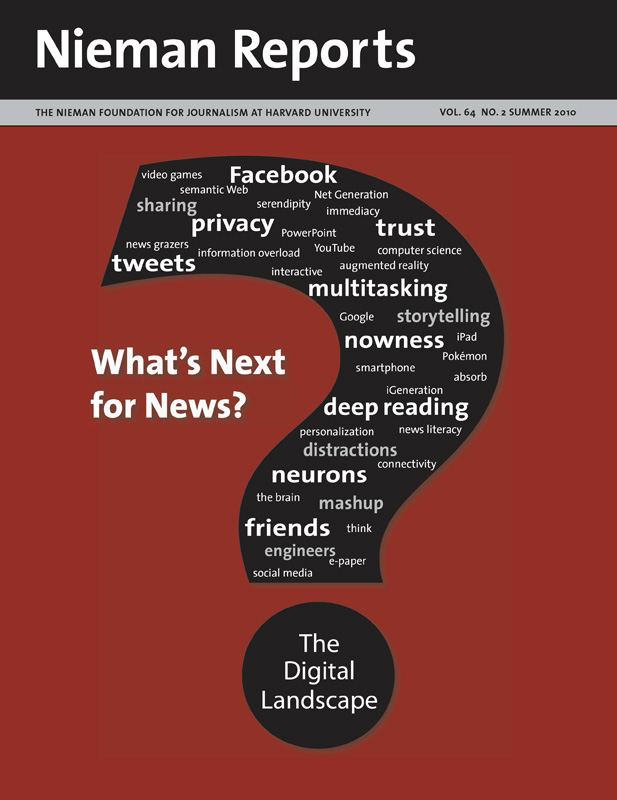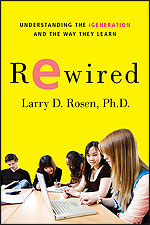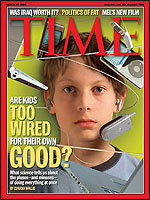Three decades have come and gone since I started to explore the impact that technology has on us. Back then we didn’t have desktop computers; the idea that one day soon we’d hold a computer in the palm of our hand seemed like something out of “Star Trek.” As I look back on these years—and on the various directions my research about the psychology of technology has taken me—I realize how strongly connected my focus in research is to changes I’ve experienced in my daily life.
When students refused to use keypunch machines, I studied computerphobia. When microwave ovens, fax machines, and desktop computers arrived, I switched to studying technophobia. And when technology became ubiquitous, I moved on to examining technostress. This happened at a time when the conversation wasn’t so much about the stress of having to use technology, but about what happens when people do, including the information overload they experience, Internet addiction, the presence and fear of online sexual predators, and cyberbullying.
At home I glimpsed these rapid technological changes through the eyes of my children. When my older son, now 34, was a teen and my younger son, now 22, a preteen, they played video games constantly, blasting aliens and splattering blood. Not surprisingly, I was drawn to studying the impact of games. Later they joined the herd in finding their way to MySpace, Facebook, IMing, texting, iPhones, and nearly everything with an “i” in it (iPod, Wii). There were times when to get my teenage daughter’s attention, I had to text her to come out of her room to join us for dinner.
Even though I’m technologically sophisticated, my kids left me in the dust—though they did so in different ways and to varying degrees. And this difference became a fascination of mine as I set out to untangle why and how the younger ones related to and handled this technology much differently than my older ones did—even though only 15 years separates them.
Waves of Technology
On the day local news reported that a man was seen walking around my campus with a gun, how I connected with members of my family signaled a turning point for me in recognizing what I’d come to understand through my research as mini-generational differences. Told to remain in my shuttered office, I e-mailed my two older kids and texted my younger ones. (Of course, I phoned my elderly parents.)
For each family member, my message was the same, “I’m O.K. Don’t worry.” Only how I relayed it was different, and that got me thinking about how rapidly changes in how we communicate are taking place. In “The Third Wave,” written in 1980, Alvin Toffler outlined his view about how waves of technology have defined our world. Toffler identified three major waves: the 3,000-year agricultural era, the 300-year industrial era, and the (projected) 30-year computer era that was on the upswing. Each wave rose and fell as new technologies arose.
Extrapolating from the pace of Toffler’s waves (dividing by 10), the fourth wave would be predicted to last for three years, the fifth for about four months, and so on. But judging from consumer product penetration rates, we were not seeing technological change taking place in months; rather, the data showed cycles of three- to five-year waves. A product is considered to have penetrated society when it reaches 50 million people. Technologies such as radio, television, and phones took more than a decade to reach this level of penetration.
As we move closer to our time, we find technology barreling its way into our society. With the Internet, instant messaging and iPods, it took only four years. Blogs took three. With MySpace, 50 million profiles were created within two and a half years: in its early years MySpace added 100,000 (mostly young) members a day. YouTube hit 50 million unique viewers in one year; in April 2008, 73 million people tuned in to YouTube videos, with teens watching an average of about 70 per month. And when the iPad went on sale in April, more than 300,000 were sold on the first day, even before the 3G model arrived in the stores.
Texting settled into the typical teen’s neighborhood even faster. Data from the Nielsen Company shows that as of late 2009 teens on average sent and received 3,186 text messages a month compared with receiving and making 196 phone calls. That works out to 10 text messages per waking nonschool hour, although we know kids text during school hours and some sleep with their cell phones so they don’t miss text messages. It is interesting to note that their Net Generation siblings—only a few years older than they are—text half as much. At the start of 2007 the monthly average for teens was 435 text messages and 255 phone calls.
Mini-Generations
As the pace of technological change accelerates, mini-generations are defined by their distinctive patterns of media use, levels of multitasking, and preferred methods of communication. Among these mini-generations, differences are also being found in their values as well as levels of social and political activism. Since Generation Xers (born between 1965 and 1979), we have seen a rapid emergence of two mini-generations, and maybe even a third. There is the young adult Net Geners (born between 1980 and 1989) followed by teen iGeners (born from 1990 to 1999), and the first generation born in the 21st century, yet unnamed and still too young to fully define.
There are some things we are starting to find out about this yet-to-be-labeled generation. Nielsen’s texting data show an average of 1,164 monthly texts for children and preteens. And the popularity of preteen and child-based social networks (e.g., Club Penguin, Barbie Girls) and the dramatic changes in media (e.g., 3-D kids’ movies) lead us to believe that their ways of communicating and approach to getting and sharing information will be different from their teen siblings.
How this generation adapts to technology—and the impact it has on family dynamics, on the classroom experience, and on what entertainment looks like and how it is consumed—is what I am focusing on in my current research. My last book, “Me, MySpace, and I: Parenting the Net Generation,” was written with parents in mind. My new book, “Rewired: Understanding the iGeneration and the Way They Learn” is aimed at a different audience. It portrays teen lifestyles in the sea of technology and challenges parents and educators—and anyone, such as journalists, who might be looking for constructive ways to interact with this generation—to take this knowledge about the intersection of technology and learning and use it to find the most effective ways to teach and communicate.
Meet the iGeneration
In studies of thousands of children, teens and young adults we’ve completed at California State University, Dominguez Hills, my colleagues and I have found that massive amounts of media are being consumed daily. The iGeneration is already setting itself apart in its consumption patterns. Here are a few of the generational differences:
Lessons for Journalists
What do such findings mean to journalists? In short, the answer is a lot. In reporting and distributing news and information—and in their interactions—journalists need to understand how younger generations use technology, what they expect to do with it, and what they expect to receive through it. If journalists want their words and images to be engaging to Net Geners and iGeners, they need to figure out how teens and young adults operate in their high-tech world. And they need to keep up with the distinctive digital habits of mini-generations.
Information is power, but first it needs to reach an audience. Whether the vehicle is Facebook or its next iteration—perhaps now in the making as an app—we know that as digital platforms change, so does the psychology of readers. And this includes how they relate to and deal with information. Each mini-generation is showing itself to be different—in big and discernible ways, and what makes them so different surely matters to those who are trying to reach them.
Larry Rosen is a professor of psychology and past chairman of that department at California State University, Dominguez Hills. He is a research psychologist, computer educator, and the author of four books. His most recent is “Rewired: Understanding the iGeneration and the Way They Learn,” published in March by Palgrave Macmillan.
When students refused to use keypunch machines, I studied computerphobia. When microwave ovens, fax machines, and desktop computers arrived, I switched to studying technophobia. And when technology became ubiquitous, I moved on to examining technostress. This happened at a time when the conversation wasn’t so much about the stress of having to use technology, but about what happens when people do, including the information overload they experience, Internet addiction, the presence and fear of online sexual predators, and cyberbullying.
At home I glimpsed these rapid technological changes through the eyes of my children. When my older son, now 34, was a teen and my younger son, now 22, a preteen, they played video games constantly, blasting aliens and splattering blood. Not surprisingly, I was drawn to studying the impact of games. Later they joined the herd in finding their way to MySpace, Facebook, IMing, texting, iPhones, and nearly everything with an “i” in it (iPod, Wii). There were times when to get my teenage daughter’s attention, I had to text her to come out of her room to join us for dinner.
Even though I’m technologically sophisticated, my kids left me in the dust—though they did so in different ways and to varying degrees. And this difference became a fascination of mine as I set out to untangle why and how the younger ones related to and handled this technology much differently than my older ones did—even though only 15 years separates them.
Waves of Technology
On the day local news reported that a man was seen walking around my campus with a gun, how I connected with members of my family signaled a turning point for me in recognizing what I’d come to understand through my research as mini-generational differences. Told to remain in my shuttered office, I e-mailed my two older kids and texted my younger ones. (Of course, I phoned my elderly parents.)
For each family member, my message was the same, “I’m O.K. Don’t worry.” Only how I relayed it was different, and that got me thinking about how rapidly changes in how we communicate are taking place. In “The Third Wave,” written in 1980, Alvin Toffler outlined his view about how waves of technology have defined our world. Toffler identified three major waves: the 3,000-year agricultural era, the 300-year industrial era, and the (projected) 30-year computer era that was on the upswing. Each wave rose and fell as new technologies arose.
Extrapolating from the pace of Toffler’s waves (dividing by 10), the fourth wave would be predicted to last for three years, the fifth for about four months, and so on. But judging from consumer product penetration rates, we were not seeing technological change taking place in months; rather, the data showed cycles of three- to five-year waves. A product is considered to have penetrated society when it reaches 50 million people. Technologies such as radio, television, and phones took more than a decade to reach this level of penetration.
As we move closer to our time, we find technology barreling its way into our society. With the Internet, instant messaging and iPods, it took only four years. Blogs took three. With MySpace, 50 million profiles were created within two and a half years: in its early years MySpace added 100,000 (mostly young) members a day. YouTube hit 50 million unique viewers in one year; in April 2008, 73 million people tuned in to YouTube videos, with teens watching an average of about 70 per month. And when the iPad went on sale in April, more than 300,000 were sold on the first day, even before the 3G model arrived in the stores.
Texting settled into the typical teen’s neighborhood even faster. Data from the Nielsen Company shows that as of late 2009 teens on average sent and received 3,186 text messages a month compared with receiving and making 196 phone calls. That works out to 10 text messages per waking nonschool hour, although we know kids text during school hours and some sleep with their cell phones so they don’t miss text messages. It is interesting to note that their Net Generation siblings—only a few years older than they are—text half as much. At the start of 2007 the monthly average for teens was 435 text messages and 255 phone calls.
Mini-Generations
As the pace of technological change accelerates, mini-generations are defined by their distinctive patterns of media use, levels of multitasking, and preferred methods of communication. Among these mini-generations, differences are also being found in their values as well as levels of social and political activism. Since Generation Xers (born between 1965 and 1979), we have seen a rapid emergence of two mini-generations, and maybe even a third. There is the young adult Net Geners (born between 1980 and 1989) followed by teen iGeners (born from 1990 to 1999), and the first generation born in the 21st century, yet unnamed and still too young to fully define.
There are some things we are starting to find out about this yet-to-be-labeled generation. Nielsen’s texting data show an average of 1,164 monthly texts for children and preteens. And the popularity of preteen and child-based social networks (e.g., Club Penguin, Barbie Girls) and the dramatic changes in media (e.g., 3-D kids’ movies) lead us to believe that their ways of communicating and approach to getting and sharing information will be different from their teen siblings.
How this generation adapts to technology—and the impact it has on family dynamics, on the classroom experience, and on what entertainment looks like and how it is consumed—is what I am focusing on in my current research. My last book, “Me, MySpace, and I: Parenting the Net Generation,” was written with parents in mind. My new book, “Rewired: Understanding the iGeneration and the Way They Learn” is aimed at a different audience. It portrays teen lifestyles in the sea of technology and challenges parents and educators—and anyone, such as journalists, who might be looking for constructive ways to interact with this generation—to take this knowledge about the intersection of technology and learning and use it to find the most effective ways to teach and communicate.
Meet the iGeneration
In studies of thousands of children, teens and young adults we’ve completed at California State University, Dominguez Hills, my colleagues and I have found that massive amounts of media are being consumed daily. The iGeneration is already setting itself apart in its consumption patterns. Here are a few of the generational differences:
- Increased media consumption: In anonymous online surveys, we asked about daily hours online and a number of activities, including music listening, video game playing, talking on the telephone, IMing and chatting, texting, sending and receiving e-mail, and watching television. While we computed a total score, we know that many of these activities are done simultaneously. Net Geners and older teens spend more than 20 hours per day using media and technology followed by younger teens who spend slightly more than 15 hours per day.
- Multitasking: Older teens report doing the most multitasking; according to them, they perform nearly seven simultaneous tasks. In “Rewired,” I argue that they are not really doing them at the same time, but they are simply better task switchers. This constant multitasking among teens compares with six and a half simultaneous activities for younger teens and six for Net Geners. Baby boomers like me report being able to do about four and a half things at the same time.
- E-communication: Baby boomers prefer face-to-face or telephone communication along with e-mail. Gen Xers embrace cell phones, e-mail and instant messaging. It is with the Net Generation that different communication approaches emerge, including social networks, IMing, Skyping and texting. But it’s the iGeneration that is rapidly redefining digital communication. To them, a phone is not a phone. It is a computer (or likely soon to be a tablet) that they use to tweet, Facebook and, of course, text, text, text. For them, peer relationships are all about connecting by any electronic means. To them, WWW stands for whatever, whenever and wherever.
- Socializing: The two recent mini-generations are more technologically social than any that came before them. For them, connecting is what digital technology was invented to do. They built MySpace and Facebook; nearly every one of them has a page on one or both. Upward of two hours each day are spent connecting online with their community of friends, whether they are RL (real life) or SL (screen life) friends. (In 2009, “unfriend” was the word of the year added to the New Oxford American Dictionary.)
- Creativity: They make their own YouTube videos, post photos, mash up music, create multimedia presentations, and develop personalized content. In their eyes, the “i” in iGeneration stands for “individualized.” iGeners have their own iPhone apps, their own song mixes, and have forced developers to mine their products for personalized applications.
- Writing: Some argue that LOL, JK, and OMG are symptoms of an illiterate generation of teen texters. Research is showing that isn’t true. This generation writes more than any other and whether it is text-based writing or formal writing, it is still writing. And writing begets writing. Interestingly, they also read more, particularly if you expand the concept of reading to include online content rather than just books in print.
- Motivation: iGen teens are highly motivated, as evidenced by the content that they post daily online. They are not, as some people have asserted, lazy. In contrast, other generations—particularly baby boomers and Gen Xers—are as interested in process as they are in product. Young adults and teenagers hate meeting to discuss how they are proceeding; if forced to meet in person, they’ll usually pull out their Blackberries and iPhones so they can multitask. They do not like interim deadlines and prefer to be held accountable for the entire project executed well and on time. They thrive on positive reinforcement for their completed work, but tend to downplay praise for subproducts along the way. From all of my research, as long as adults let teens work on their time schedule, using high-tech tools they prefer, teachers and employers will most often find that iGeners and Net Geners will come up with an excellent final product.
Lessons for Journalists
What do such findings mean to journalists? In short, the answer is a lot. In reporting and distributing news and information—and in their interactions—journalists need to understand how younger generations use technology, what they expect to do with it, and what they expect to receive through it. If journalists want their words and images to be engaging to Net Geners and iGeners, they need to figure out how teens and young adults operate in their high-tech world. And they need to keep up with the distinctive digital habits of mini-generations.
Information is power, but first it needs to reach an audience. Whether the vehicle is Facebook or its next iteration—perhaps now in the making as an app—we know that as digital platforms change, so does the psychology of readers. And this includes how they relate to and deal with information. Each mini-generation is showing itself to be different—in big and discernible ways, and what makes them so different surely matters to those who are trying to reach them.
Larry Rosen is a professor of psychology and past chairman of that department at California State University, Dominguez Hills. He is a research psychologist, computer educator, and the author of four books. His most recent is “Rewired: Understanding the iGeneration and the Way They Learn,” published in March by Palgrave Macmillan.






